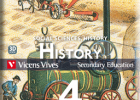Art in the 19th century
The end of the 18th century marked a transition from Rococo art, which embodied the aesthetics of the Ancien Régime, to neoclassicism. Neoclassicism was based on the classical art and culture of Ancient Greece and Rome, and on rationality. Art in the 19th century reflected the social and political transformations of the time. [...]
Esta secuencia contiene:
-
13 actividades
-
79 recursos
-
Idioma:
- Inglés
-
Formato:
Interactivo
Secuencia didáctica
-
Didactic objectives Know, analyse and explain the main art movements of the 19th century. [...]
-
1. Art at the end of the 18th century Rococo art first appeared in France in the 18th century and later spread throughout Europe. Rococo architecture was modelled on the Baroque style and was used in both religious and civil buildings. [...]
-
The end of the 18th century marked a transition from Rococo art, which embodied the aesthetics of the Ancien Régime, to neoclassicism. Neoclassicism was based on the classical art and culture of Ancient Greece and Rome, and on rationality. [...]
-
1.1. Rococo art in Europe Rococo art first appeared in France in the 18th century and later spread throughout Europe. It was elegant and refined, and reflected the tastes of the aristocracy and the urban bourgeoisie. [...]
-
Neoclassicism was a movement in Europe between 1760 and 1830 that was inspired by Enlightenment thought, the Revolution in France and the discovery of ancient archaeological sites during that period. 2.1. [...]
-
3.1. Historicism In the middle of the 19th century, nationalist ideals prompted people to look to their past, mainly to the Middle Ages, in an attempt to find their roots. [...]
-
Romanticism was a movement that spread across Europe at the beginning of the 19th century. The Romantic era not only encompassed an artistic movement, but an intellectual one too that had clear political connotations. [...]
-
5.1. An objective reality In the middle of the 19th century, Romanticism was replaced by Realism. [...]
-
6.1. Impressionism The Impressionist movement began towards the end of the 19th century. The style of painting in this period placed a lot of emphasis on the play of light, and how it could alter a scene and the objects within it. [...]
-
Modernism was a movement that emerged in Europe between 1890 and 1910. It was also known as Art Nouveau (France), Stile Liberty (Italy), Jugendstil (Germany) and Sezessionstil (Austria). [...]
-
During the 19th century, Spain followed the same artistic movements as the rest of Europe. 8.1. Architecture Neoclassical architecture took root in Spain in 1760 as a result of significant changes to Madrid's urban planning. [...]
-
The end of the 18th century marked a transition from Rococo art, which embodied the aesthetics of the Ancien Régime, to neoclassicism. Neoclassicism was based on the classical art and culture of Ancient Greece and Rome, and on rationality. [...]
-
The end of the 18th century marked a transition from Rococo art, which embodied the aesthetics of the Ancien Régime, to neoclassicism. Neoclassicism was based on the classical art and culture of Ancient Greece and Rome, and on rationality. [...]
Cursos y asignaturas
-
15 años:
- Historia
-
16 años:
- Historia
-
Aún no hay comentarios, ¡comparte tu opinión! Inicia sesión o Únete a Tiching para poder comentar
La licencia digital es una autorización que permite utilizar un recurso digital de acuerdo con las condiciones legales de dicho recurso. El código que recibas una vez la hayas comprado te permitirá acceder al recurso educativo digital elegido.
Puedes consultar más información en nuestra página de ayuda.






















































































¿Dónde quieres compartirlo?
¿Quieres copiar el enlace?